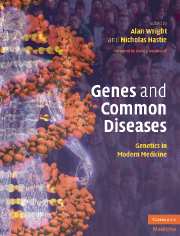Book contents
- Frontmatter
- Contents
- List of Contributors
- Foreword
- Section 1 Introductory Principles
- Section 2 Common Medical Disorders
- 13 Developmental disorders
- 14 Genes, environment and cancer
- 15 The polygenic basis of breast cancer
- 16 TP53: A master gene in normal and tumor suppression
- 17 Genetics of colorectal cancer
- 18 Genetics of autoimmune disease
- 19 Susceptibility to infectious diseases
- 20 Inflammatory bowel diseases
- 21 Genetic anemias
- 22 Genetics of chronic disease: obesity
- 23 Type 2 diabetes mellitus
- 24 Genetics of coronary heart disease
- 25 Genetics of hypertension
- 26 Obstructive pulmonary disease
- 27 Skeletal disorders
- 28 The genetics of common skin diseases
- 29 Molecular genetics of Alzheimer's disease and other adult-onset dementias
- 30 Major psychiatric disorders in adult life
- 31 Speech and language disorders
- 32 Common forms of visual handicap
- 33 Genetic and environmental influences on hearing impairment
- 34 Pharmacogenomics: clinical applications
- Index
- References
30 - Major psychiatric disorders in adult life
Published online by Cambridge University Press: 17 August 2009
- Frontmatter
- Contents
- List of Contributors
- Foreword
- Section 1 Introductory Principles
- Section 2 Common Medical Disorders
- 13 Developmental disorders
- 14 Genes, environment and cancer
- 15 The polygenic basis of breast cancer
- 16 TP53: A master gene in normal and tumor suppression
- 17 Genetics of colorectal cancer
- 18 Genetics of autoimmune disease
- 19 Susceptibility to infectious diseases
- 20 Inflammatory bowel diseases
- 21 Genetic anemias
- 22 Genetics of chronic disease: obesity
- 23 Type 2 diabetes mellitus
- 24 Genetics of coronary heart disease
- 25 Genetics of hypertension
- 26 Obstructive pulmonary disease
- 27 Skeletal disorders
- 28 The genetics of common skin diseases
- 29 Molecular genetics of Alzheimer's disease and other adult-onset dementias
- 30 Major psychiatric disorders in adult life
- 31 Speech and language disorders
- 32 Common forms of visual handicap
- 33 Genetic and environmental influences on hearing impairment
- 34 Pharmacogenomics: clinical applications
- Index
- References
Summary
Psychiatric disorders are common. The World Health Organization (WHO) estimates that at least one in four people will experience a clinically significant episode of psychiatric illness at some point in their lives. Although most such disorders are short lived and do not result in specialist care many cases become disabling and the WHO Global Burden of Disease Study (Murray and Lopez, 1997) has estimated that in health economic terms unipolar depression (UPD) vies with cardiovascular disease as the leading cause of disability in adults world wide. Schizophrenia and bipolar affective disorder (BPD) are also major public health problems which feature in the WHO's top ten of economically burdensome diseases. Between them, the affective disorders (UPD and BPD) and schizophrenia also account for over 60% of completed suicides. Therefore we will here focus on these three conditions as the main exemplars of common complex psychiatric disorders with substantial genetic contributions.
Clinical features and epidemiology
Unipolar depression (UPD) is so called because it consists of episodes of depressed mood whereas bipolar disorder (BPD) presents as episodes of both mania and depression. (A minority of patients with bipolar disorder have episodes of mania and no depressive episodes, but in terms of course, outcome, treatment response and pattern of illness in relatives they resemble typical bipolar disorder cases and are therefore classified as such rather than a “unipolar mania”).
- Type
- Chapter
- Information
- Genes and Common DiseasesGenetics in Modern Medicine, pp. 454 - 468Publisher: Cambridge University PressPrint publication year: 2007

